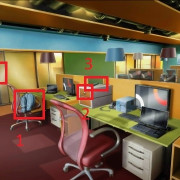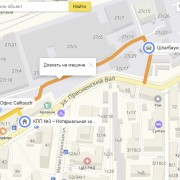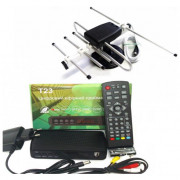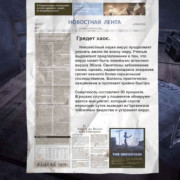Extreme reactors 1.12.2 wiki
Содержание:
- Принцип работы жидкостного ядерного реактора[]
- Optimal Ultra High Speed Turbines (> 2,000 RPM)[edit]
- Building It[]
- Крафт добавляемый плагином NuclearMC:
- Optimal Unattended Enderium Designs[edit]
- Note[edit]
- Turbine[edit]
- Coolant[]
- Подробнее о предметах плагина NuclearMC:
- Optimal Ultra High Speed Endgame Designs[edit]
- Reactor Parts[]
- Пример постройки[]
- Reactor[edit]
Принцип работы жидкостного ядерного реактора[]
Принцип работы состоит в том, что вместо выделения энергии напрямую, происходит передача тепла хладагенту. Причём это то тепло, которое рассеивают охлаждающие компоненты во внутренней схеме. То есть теперь чем больше тепла выделяется и рассеивается, тем больше энергии получится в результате. Схемы для жидкостного ядерного реактора аналогичны схемам для обычного реактора. Более подробное описание схем и их компонентов смотрите в статье про ядерный реактор.
Дальше чтобы из горячего хладагента получить энергию его следует извлечь из реактора и охладить при помощи жидкостных теплообменников. В результате получается тепловая энергия. Следует отметить что при охлаждении горячего хладагента он становится обычным и его можно залить обратно в реактор. Таким образом хладагент не расходуется в процессе работы, а только передаёт тепловую энергию.
Теперь тепловую энергию нужно преобразовать в электрическую. Это можно сделать различными способами.
Первый способ — генераторы Стирлинга. Есть обычная версия генератора и кинетическая. Кинетический генератор Стирлинга выгоднее, но он неработоспособен без возможности утилизации жидкостей.
Второй способ — пар. Он производится при помощи парогенераторов и подается в турбины. В этом случае это гораздо больше похоже на работу настоящего реактора. При наличии Railcraft даже можно использовать его паровые турбины. Для получения пара лучше использовать дистиллированную воду, иначе при использовании обычной воды в парогенераторе образуется накипь, которая со временем приводит к аварийной остановке. Поскольку дистиллированную воду получать очень долго, то как правило используется схема с замкнутым циклом, в которой она превращается в пар и затем конденсируется обратно практически без потерь. Для этого после турбин ставится конденсатор. Чтобы в итоге получить электричество турбины конечно следует подключить к кинетическим генераторам.
Optimal Ultra High Speed Turbines (> 2,000 RPM)[edit]
- Usually operate above 2000 RPM, except for the highest tier materials.
- Built with exactly 80 rotor blades.
- They use the maximum of 2000 mB/t of steam.
| Block | Coils | Speed | Energy | RF/t/coil |
|---|---|---|---|---|
| Ludicrite | 32 | 1,782.4 | 28,073 | 877 |
| Enderium | 37 | 1,798.4 | 24,090 | 651 |
| Orichalcum Orichalcum | 26 | 4,500 | 15,090 | 580 |
| Haderoth Haderoth | 37 | 2,690 | 17,650 | 530 |
| Titanium Titanium | 41 | 1,803.3 | 20,415 | 497 |
| Celenegil Celenegil | 49 | 1,800 | 21,640 | 440 |
| Platinum | 44 | 1,814.7 | 19,721 | 448 |
| Shiny | 44 | 1,814.7 | 19,721 | 448 |
| Tartarite Tartarite | 44 | 1,800 | 19,660 | 445 |
| Electrum | 37 | 2,690 | 16,370 | 440 |
| Quicksilver Quicksilver | 41 | 2,690 | 17,040 | 415 |
| Gold | 42 | 2,700 | 13,100 | 310 |
| Mithril Mithril | 49 | 2,700 | 14,400 | 295 |
| Steel | 34 | 4,485 | 9,810 | 290 |
| Aluminum | 34 | 4,485 | 9,810 | 290 |
| Invar | 39 | 3,620 | 9,740 | 250 |
| Silver | 49 | 2,700 | 11,140 | 225 |
| Brass | 46 | 3,590 | 9,170 | 200 |
| Osmium | 46 | 3,590 | 9,170 | 200 |
| Copper | 46 | 3,590 | 7,860 | 170 |
| Iron | 44 | 4,500 | 6,530 | 150 |
Building It[]
Reactors and turbines are multi-block structures: they are made up of individual blocks arranged according to specific rules which together create a large functional machine. Both reactors and turbines must be built as a closed, mostly hollow box with no holes and complete edges, including corners. The edges of this box must be Reactor Casing or Turbine Housing, and the faces Reactor Glass or Turbine Glass, respectively.
In addition to these containment blocks, a number of other blocks are necessary to make a functioning reactor or turbine. None of the these blocks can be placed on the edge or corner; they must be somewhere in the faces of the reactor, sometimes in very specific places. Right clicking on the reactor casing or turbine housing will tell you if anything is missing.
Important: Ensure there are no metallic blocks within a 1 block radius of your turbine! Doing so results in unpredictable behavior with the turbine.
Download this spreadsheet to calculate the required materials and their cost for any size Reactor structure.
Use this Big Reactor Simulator to test the efficiency of different Reactor design.
Крафт добавляемый плагином NuclearMC:
Атомная бомба
Железный блок, Ядро реактора, Железный блокЖелезный блок, Топливный стержень, Железный блокЖелезный блок, Фейерверк, Железный блок
Топливный стержень
Железный слиток, ОБОГАЩЕННЫЙ УРАН, Железный слитокЖелезный слиток, ОБОГАЩЕННЫЙ УРАН, Железный слитокЖелезный слиток, ОБОГАЩЕННЫЙ УРАН,Железный слиток
Водородная бомба
Железный блок, Ядро реактора, Железный блокЖелезный блок, Звезда незера, Железный блокЖелезный блок, Фейерверк, Железный блок
Ядро реактора
Железный блок, Редстоун, Железный блокРедстоун, Алмазный блок, РедстоунЖелезный блок, Редстоун, Железный блокУрановая рудаПолучено в результате полезных ископаемых
Optimal Unattended Enderium Designs[edit]
Note: This guide was written before Ludicrite was added to the game. Ludicrite is now the best material.
For instance, a turbine spinning at a suboptimal 1781 RPM (using 32 blocks of Ludicrite) generates 28050 RF.
All optimal end game designs use 37 Enderium coil blocks (3 blocks short of 5 full rings) with a supply of 2,000mB/t of steam.
Note: only includes designs with a constant rotor speed.
Dimensions include turbine housing blocks. Height is the axis with the rotor shaft. Amount of Cyanite does not include that needed by fluid ports, controllers, power ports, etc. because that amount is independent of turbine dimensions.
| Width | Height | Cyanite | Total Vol. | Empty Vol. | RPM | RF/t | RF/t/m³ | RF/t/cyan | Comment |
|---|---|---|---|---|---|---|---|---|---|
| 5 | 27 | 547 | 675 | 83 | 1,797.4 | 24,077 | 35.67 | 44 | Highest energy per cubic metre. |
| 7 | 17 | 529 | 833 | 243 | 1,797.4 | 24,077 | 28.9 | 45.5 | Highest energy per cyanite ingot. |
| 13 | 11 | 739 | 1,859 | 963 | 1,797.4 | 24,077 | 12.95 | 32.5 | Highest energy per height. |
The first example above with the highest energy per cubic metre needs:
— 80 Turbine Rotor Blades
— 25 Turbine Rotor Shafts
— 37 Enderium Blocks
— 132 Turbine Housing
~ 312 Turbine Glass
— 1 each: Turbine Power Port, Turbine Controller, Turbine Rotor Bearing
— at least 2 Turbine Fluid Ports (1 input and 1 output)
(edit: properly adjusted requirements)
Using the most space efficient design, each turbine block consumes ~3 mB of steam and produces 35.67 RF per tick = ~12 RF/t/mB/m³. Mekanism 9 (available for Minecraft 1.7.10+) now produces even more power, and for a cheaper, faster, and smaller setup.
Note[edit]
- It is important to note that the coolant discussed in this section is completely unrelated to the Reactor Coolant Port. These would be more accurately described as the moderating material of the reactor, whereas the coolant port accepts only water for the generation of steam.
- Fantasy Metals: Mithril, Orichalcum, Quicksilver, Haderoth, Celenegil, Tartarite and Manyullyn may also be used as coolant material.
- ↑ Some of the materials above don’t work in the Big Reactor on MC 1.6.4
- As of v0.3.4A2, any material will have a mass of 10 units per block. In the future the mod developer plans to allow the rotor to be constructed out of different materials.
- ↑ These six materials only work if the use of fantasy metals is enabled in the Big Reactor config file.
Turbine[edit]
A Turbine produces energy from Steam generated by an active cooling Reactor or generated using one of 6 other mods methods. Steam is converted back into water, which may be recycled into a Reactor to produce more steam.
Turbine Coil Materialedit
The three values are always averaged together to give the resulting values for the entire turbine coil. A higher efficiency will always produce more power. A higher drag will produce more power, but will slow down the rotor more when induction is enabled. A higher bonus will also always produce more power.
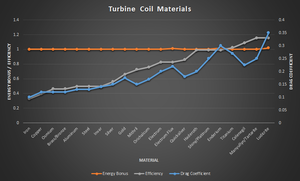
| Block | Efficiency | Drag | Bonus |
|---|---|---|---|
| Iron | 0.33 | 0.1 | 1 |
| Copper | 0.396 | 0.12 | 1 |
| Osmium | 0.462 | 0.12 | 1 |
| Brass | 0.462 | 0.12 | 1 |
| Aluminum | 0.495 | 0.13 | 1 |
| Steel | 0.495 | 0.13 | 1 |
| Invar | 0.495 | 0.14 | 1 |
| Silver | 0.561 | 0.15 | 1 |
| Gold | 0.66 | 0.175 | 1 |
| Electrum | 0.825 | 0.2 | 1 |
| Fluxed Electrum Fluxed Electrum | 0.825 | 0.22 | 1.01 |
| Platinum | 0.99 | 0.25 | 1 |
| Shiny Shiny | 0.99 | 0.25 | 1 |
| Titanium | 1.023 | 0.27 | 1 |
| Enderium Enderium | 0.99 | 0.3 | 1.02 |
| Ludicrite Ludicrite | 1.155 | 0.35 | 1.02 |
| Mithril | 0.726 | 0.15 | 1 |
| Orichalcum Orichalcum | 0.759 | 0.17 | 1 |
| Quicksilver | 0.858 | 0.18 | 1 |
| Haderoth Haderoth | 0.99 | 0.2 | 1 |
| Celenegil Celenegil | 1.089 | 0.225 | 1 |
| Tartarite Tartarite | 0.99 | 0.25 | 1 |
Turbine Optimizationedit
- Turbines convert steam into water at an even ratio, and produce a certain amount of RF per tick depending on the coil material and turbine design.
- Steam intake is always between 0 and 2,000 mB per tick.
- The rotor speed gauge only shows between 0 and 2,200 RPM, but the actual rotor speed can be higher.
- Generated energy is always positive or 0.
- The width of the turbine frame is not a factor of energy output.
- The number of rotor shafts isn’t a very large factor of energy output. Dimensions used are at the Player’s discretion.
- If maximum rotor speed is unlimited and 2,000 mB per tick of steam is available, it is most efficient to use 80 rotor blades. If the rotor speed is limited to 2,000 RPM, perhaps more rotor shafts and fewer rotor blades would be preferable in order to keep the rotor speed above 1,796.27 but below 2,000 RPM while optimizing energy output.
- All blocks of the coil do not need to be made of the same material, but are averaged together to determine the turbine’s score in each of the three coil traits. This makes it possible to make composite coils that use cheap filler metals in balance with high end metals to maximize limited resources. It also means, however, that adding a ring of a low performing metal to a turbine with several rings of a high-perfomance metal may actually reduce the output.
Turbine Equationedit
- BladeSurfaceArea = Number of rotor blades in the turbine.
- RotorMass = Total combined mass of the rotor blades and rotor shafts. See the table above for the mass of each block.
- CoilSize = The number of coil blocks in the turbine.
- InductorEfficiency, InductorDrag, InductorBonus = The average Efficiency, Drag, and Bonus of each coil block (from the table above).
- RotorSpeed = The speed of the rotor as displayed in the turbine controller GUI.


The turbine is at maximum efficiency (100%) at 898.134 RPM and 1796.27 RPM. It has an efficiency of 50% when less than 500 RPM, and at 1347.2 RPM. This doesn’t mean, however, that a turbine is most energy efficient at 1796 RPM.

Rotor energy in terms of ticks elapsed:

Where C is a constant that must be calculated based on initial values. If the turbine is just being started, then C is zero. OR, in terms of the RotorEnergy of the previous tick:

Rotor energy when turbine is running continuously:
a and b are both constant and are only dependent on the design of the turbine and the control values in the turbine controller.


If the turbine inductor is disengaged then InductionTorque equals zero.


Coolant[]
A coolant reduces the temperature of a reactor, and moves heat from the reactor core to the reactor casing. The higher the casing heat, the higher the energy output and heat transfer rate of coolants.
It is important to note that the coolant discussed in this section is completely unrelated to the Reactor Coolant Port. These would be more accurately described as the moderating material of your reactor, whereas the coolant port accepts only water for the generation of steam. Any fluid coolants must be manually added to the reactor during construction, exactly as you would with solid coolant materials. Those looking to fill large reactors with fluids that fall, such as Gelid Cryotheum, may want to consider using buildcraft’s Flood Gate.
Each material has various parameters that govern how it affects the reactor:
- Absorption: How much radiation this material absorbs and converts to heat. Ranges from 0 (none) to 1 (all).
- Heat Efficiency: How efficiently radiation is converted to heat. Ranges from 0 (none) to 1 (all).
- Moderation: How well this material moderates radiation. This is a divisor, and greater than or equal to 1.
- Conductivity: Amount of heat transfered on each exposed face.
| Block | Absorption | Heat Efficiency | Moderation | Conductivity |
|---|---|---|---|---|
| Iron | 0.5 | 0.75 | 1.5 | 0.6 |
| Gold | 0.52 | 0.8 | 1.45 | 2 |
| Diamond | 0.55 | 0.85 | 1.5 | 3 |
| Emerald | 0.55 | 0.85 | 1.5 | 2.5 |
| Graphite | 0.1 | 0.5 | 2 | 2 |
| Glass | 0.2 | 0.25 | 1.1 | 0.3 |
| Ice | 0.33 | 0.33 | 1.15 | 0.1 |
| Snow | 0.15 | 0.33 | 1.05 | 0.05 |
| Copper | 0.5 | 0.75 | 1.4 | 1 |
| Osmium | 0.51 | 0.77 | 1.41 | 1 |
| Brass | 0.51 | 0.77 | 1.41 | 1 |
| Bronze | 0.51 | 0.77 | 1.41 | 1 |
| Zinc | 0.51 | 0.77 | 1.41 | 1 |
| Aluminum | 0.5 | 0.78 | 1.42 | 0.6 |
| Steel | 0.5 | 0.78 | 1.42 | 0.6 |
| Invar | 0.5 | 0.79 | 1.43 | 0.6 |
| Silver | 0.51 | 0.79 | 1.43 | 1.5 |
| Lead | 0.75 | 0.75 | 1.75 | 1.5 |
| Electrum | 0.53 | 0.82 | 1.47 | 2.2 |
| Fluxed Electrum | 0.54 | 0.83 | 1.48 | 2.4 |
| Platinum | 0.53 | 0.86 | 1.58 | 2.5 |
| Shiny | 0.53 | 0.86 | 1.58 | 2.5 |
| Titanium | 0.53 | 0.87 | 1.59 | 2.7 |
| Enderium | 0.53 | 0.88 | 1.6 | 3 |
| Water | 0.33 | 0.5 | 1.33 | 0.1 |
| Destabilized Redstone | 0.75 | 0.55 | 1.6 | 2.5 |
| Energized Glowstone | 0.2 | 0.6 | 1.75 | 1 |
| Gelid Cryotheum | 0.66 | 0.95 | 6.0 | 3 |
| Resonant Ender | 0.9 | 0.75 | 2.0 | 2 |
| Blazing Pyrotheum | 0.66 | 0.9 | 1.0 | 0.6 |
| Life Essence | 0.7 | 0.55 | 1.75 | 2 |
Подробнее о предметах плагина NuclearMC:
Уран
• Урановая руда может быть получена путем добычи. Различные руды / блоки имеют настраиваемую вероятность выпадения урановой руды при добыче.
• Урановая руда бесполезна до тех пор, пока ее не обогатят путем плавки. Обогащенный уран используется для изготовления топливных стержней для реакторов и ядерного оружия.
Ядерные реакторы
• Чтобы создать ядерный реактор, вам необходимо разместить 1 активную зону реактора, 3 котла, 1 бункер и 1 печь в конфигурации, показанной ниже (примечание: печь должна быть размещена последней):
• Чтобы использовать ядерный реактор, просто поместите топливные стержни в бункер. По умолчанию 1 топливный стержень будет питать печь столько же времени, сколько ведро лавы (1000 секунд).
• Радиоактивные ядерные отходы будут образовываться во время работы реактора и будут помещены в бункер или сброшены на землю, если бункер заполнен.
Ядерные отходы будут излучать игроков, если они будут держать их в своем инвентаре или стоять рядом с ними, когда они лежат на земле. Носите защитное снаряжение, чтобы уменьшить его эффект!
• Пока реактор работает, он израсходует воду в котлах. По умолчанию каждые 30 секунд используется 1 уровень воды в котле.Если в реакторе закончится вода, он расплавится (взрыв + радиация в окрестностях)
Ядерное оружие
• Есть два вида ядерного оружия: атомная бомба и водородная бомба.
• Оба оружия вызывают сильный взрыв при ударе и излучают окружающее пространство, но водородная бомба более мощная.
• Чтобы запустить ядерное оружие, щелкните предмет, глядя в том направлении, в котором вы хотите запустить ракету, и она взорвется при ударе.
Радиация
• Уровень радиации игроков отображается на панели босса, как показано ниже (панель босса исчезнет, когда их уровень излучения будет равен 0).
• Источники излучения включают: хранение ядерных отходов, стояние рядом с ядерными отходами, аварии реакторов, ядерное оружие и регионы Worldguard с флагом рад в секунду.
• Эффекты излучения настраиваются, но по умолчанию эффекты следующие: слабость, начинающаяся с 25 рад, тошнота с 50 рад, увядание с 75 рад и вред со 100 рад.• Уровень радиации игроков будет медленно снижаться с течением времени, или они могут использовать таблетки радиации, чтобы значительно снизить уровень радиации.
• Количество радиации, получаемой игроком от источника радиации, можно уменьшить, надев защитную экипировку. Для каждого элемента защитного снаряжения, который носит игрок, количество получаемых рад уменьшается на 25%, поэтому, если игрок носит полный защитный костюм, он полностью защищен от любого излучения. По умолчанию,Рецепты изготовления хазматов такие же, как и у обычных доспехов, но материал — губка.
Optimal Ultra High Speed Endgame Designs[edit]
Optimal Ultra High Speed endgame turbines consists of Enderium, platinum or sometimes ludicrite blocks to get a high efficiency, but keep the amount of these materials low for save on materials and consequently increasing the turbine’s operation speed. Always leave 1 meter of space between the lowest Turbine Rotor Blade and the highest coil, this will reduce drag on the rotor and give you maximum efficiency. Do note that these turbines start up slower the higher designed speed it has, so build turbine that runs on less than 3,600 RPM if one wants quick power. Also the mod author will make the turbine explode above 2,000 RPM in a future update, when the update occurs all the turbines already operating above that speed will be deactivated and their speed reset to 0. Don’t be foolish and start them up again!
As a reference, the 1,800 RPM optimal end game turbine design consists of 37 Enderium blocks and generate 24,077 RF/t at 2,000 steam mB/t. All turbines below contain 80 turbine rotor blades, as their steam intake is 2,000 mB/t. A good 2,700 RPM design consists of 25 Enderium blocks and 2 platinum blocks. It should generate about the same amount of power as turbines of 1,800 RPM designs mentioned above, due to platinum and Enderium blocks having the same efficiency. A 3,600 RPM design includes 16 Enderium blocks and 3 platinum blocks. It should also generate about the same amount of power as the 1,800 RPM optimal turbines. Materials used to build higher speed turbines can be easily calculated. A platinum block should count as 5/6 Enderium blocks in the calculation. If you want to build a 9,000 RPM turbine, for example, it is 5×1,800 RPM so the turbine should have 37/5 Enderium blocks which approximate to 7 blocks (Always round down: If you round down and the turbine is spinning faster than expected, lower steam intake a little). Therefore, 4 Enderium blocks and 4 platinum blocks should be used in the turbine.
Ludicrite block turbines are ludicrous. By using only 4 blocks of Ludicrite as the coil material and using a minimum of 76 blades, setting the fluid intake to 1918 mB/t will make the turbine reach 13,478.1 RPM and generate 26,531 RF/t. It is even better than a optimal 1,800 RPM design and is much cheaper.
Reactor Parts[]
Reactor Controller
All reactors must have exactly one Reactor Controller block. This block provides the main interface for monitoring the status of the reactor.
Reactor Access Port
Access Ports are buffers that contain unused fuel and waste. Right-clicking a port brings up an interface that allows to add fuel, remove waste, and toggle inlet/outlet mode. An active reactor will use the fuel from the ‘Inlet’ port and dump waste into the ‘Outlet’ port.
A Big Reactor needs at least one access port.
Yellorium Fuel Rod
The core of the reactor is an arrangement of Yellorium Fuel Rods. These must be stacked to stretch the entire interior height of the reactor. The entire volume of the reactor may be filled with fuel rods, but it does not have to be.
Reactor Control Rod
Above each stack of fuel rods there must be a Reactor Control Rod, this block tells the reactor where the fuel rods are so it can fill them with fuel.
Reactor Power Tap
Reactors that provide RF energy directly need to have at least one Reactor Power Tap as part of the structure.
The Power Tap can attach to any compatible Cable or Conduit that accepts RF power.
Reactor Coolant Port
Coolant Ports allow fluids to be injected into and drained from the reactor. Reactors that provide RF directly use coolant ports to keep the core at a safe operating temperature. Those that run steam turbines use coolant ports to feed the turbine with steam.
Reactor Computer Port
The Computer Port intalled on a Reactor, allows ComputerCraft blocks and items to control it.
Reactor RedNet Port
Like the Computer Port, the RedNet Port allows a reactor to interface with a RedNet network.
Пример постройки[]
Строим квадратную площадку 5х5 из реакторного корпуса .
По центру площадки ставим ядерный реактор (только на 1 блок выше). Добавляем к нему 6 реакторных камер.
Полностью закрываем блоками реакторного корпуса.
С одной стороны устанавливаем реакторный люк и реакторный проводник красного сигнала.
С другой устанавливаем 4 насоса . Во все 4 насоса ставим Выталкиватель жидкости .
Далее, на наши 4 насоса ставим 4 жидкостных теплообменника, и квадратики гаечным ключом поворачиваем друг другу, как на изображении.
Ставим 2 парогенератора .
Снизу парогенератора ставим Регулятор жидкости. Также снизу ключом shift + ПКМ кликаем по регулятору жидкости.
Ставим ещё 3 Регулятора жидкости. После установки каждого сторона выхода (с точкой) будет направлена на вас.
Нам нужно, чтобы она была направлена на предыдущий регулятор. Поэтому сразу поворачиваем их, кликая по ним ключом shift+ПКМ.
Во всех 4-х выставляем 1000 мВ/сек.
Затем ставим 2 кинетических парогенератора , и в них вставляем, паровую турбину и Выталкиватель жидкости , настроенный с нижней стороны.
Обратите внимание, что установленные механизмы должны быть повёрнуты к вам стороной с чёрным кругом как на изображении.
Иначе их следует развернуть ключом кликнув по ним ПКМ.
Рядом ставим кинетические генераторы и гаечным ключом кликаем shift + ПКМ по генераторам, чтобы развернуть их в нужную сторону.
Ставим конденсатор , в него ставим Выталкиватель жидкости тоже настроенный с нижней стороны.
И 4 теплоотвода для скорости.
Во все жидкостные теплообменники ставим по 10 теплопроводов и Выталкиватель жидкости , настроенный с любой стороны.
Потом проделываем то же самое, только сверху.
Все так же. Но, выталкиватели настраиваем с верхней стороны.
В двух парогенераторах выставляем следующие параметры: 221 Bar и внизу 1mB\tick.
Заливаем в них по 10 универсальных капсул дистиллированной воды, кликая по ним shift+ПКМ с капсулами в руке.
Далее, заходим в реакторный люк. Если он не открывается, значит реактор построен неправильно.
Рядом на реакторный проводник красного сигнала ставим рычаг. С его помощью можно включать и выключать реактор.
После того, как вы зашли, видно, что реактор работает в охлаждающем режиме на 100 %.
Слева в углу ставим капсулу с хладагентом примерно 10-20 шт. Дальше выставляем такую схему.
Соединяем проводом кинетические генераторы, конденсаторы и регуляторы жидкости (им нужно немного энергии для работы) и выводим его до вашего энергохранителя.
Дальше включаем реактор с помощью рычага. Через несколько минут парогенераторы нагреются и начнут работать.
В итоге, если всё сделано правильно, вы должны получить электричество ~300 еЭ/т. По сравнению с обычным генератором стирлинга эта конструкция вырабатывает примерно в 1,4 раза больше энергии. Таким образом, на 1 ведро горячего хладагента производится примерно 14 000 еЭ (если не учитывать то, что парогенератору нужно прогреться до 375 градусов, прежде чем начать вырабатывать пар).
Reactor[edit]
Partsedit
Reactor Controller
All reactors must have exactly one Reactor Controller block, which provides the main interface for monitoring the status of the reactor.
Access Ports are buffers that contain unused fuel and waste. Right-clicking a port brings up an interface that allows to add fuel, remove waste, and toggle inlet/outlet mode. An active reactor will use the fuel from the ‘Inlet’ port and dump waste into the ‘Outlet’ port. A Big Reactor needs at least one access port.
The core of the reactor is an arrangement of Yellorium Fuel Rods. These must be stacked to stretch the entire interior height of the reactor. The entire volume of the reactor may be filled with fuel rods, but it does not have to be. The Reactor will usually be more efficient with the Fuel Rods placed diagonally in a checker board pattern with a coolant filling the gaps.
Above each stack of Fuel Rods there must be a Reactor Control Rod, which allows the Player to adjust the depth of the Rod. It also tells the reactor where the fuel rods are so it can fill them with fuel.
Reactors that provide RF energy directly need to have at least one Reactor Power Tap as part of the structure.
The Power Tap can attach to any compatible Cable or Conduit that accepts RF power.
Coolant Ports allow fluids to be injected into and steam drained from the reactor to be transported to feed a turbine.
Reactor Computer Port
The Computer Port installed on a Reactor, allows ComputerCraft and OpenComputers blocks and items to control it.
Reactor RedNet Port
Like the Computer Port, the RedNet Port allows a reactor to interface with a RedNet network.
Reactor Temperatureedit
The fuel inside the fuel rods generates power, radiation and heat. Heat is transferred to the adjacent 4 blocks from the fuel rods into a coolant or fuel rod block, and likewise radiation is transferred up to 4 blocks (dependant on adjacent block absorption) in the cardinal directions (North,South,East,West).
Excess radiation and heat could cause the temperature in the reactor to rise above efficient levels and consume more fuel, since there is a penalty to fuel consumption at too high an operating temperature.
| Temperature (C) | < 200 | 200 to 1000 | 1000 to 2000 |
|---|---|---|---|
| Loss (%) | None | 0 to 10 | 10 to 66 |
Reactor Coolantedit
A coolant reduces the temperature of a reactor, and moves heat from the reactor core to the reactor casing. The higher the casing heat, the higher the energy output and heat transfer rate of coolants .
Any fluid used as coolant must be manually added to the reactor during construction, exactly as you would with solid coolant materials. Those looking to fill large reactors with fluids that fall, such as Gelid Cryotheum, may want to consider using a Flood Gate of Fluid Outlet.
Each coolant material has various parameters that govern how it affects the reactor :
- Absorption: How much radiation this material absorbs to convert to heat. Ranges from 0 (none) to 1 (all).
- Heat Efficiency: How efficiently absorbed radiation is converted to heat. Ranges from 0 (none) to 1 (all).
- Moderation: How well this material moderates radiation. This is a divisor, and greater than or equal to 1.
- Conductivity: Amount of heat transfered on each exposed face.
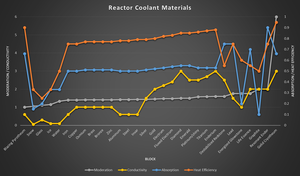
| Block | Absorption | Heat Efficiency | Moderation | Conductivity |
|---|---|---|---|---|
| Iron | 0.5 | 0.75 | 1.4 | 0.6 |
| Gold | 0.52 | 0.8 | 1.45 | 2 |
| Diamond | 0.55 | 0.85 | 1.5 | 3 |
| Emerald | 0.55 | 0.85 | 1.5 | 2.5 |
| Graphite | 0.1 | 0.5 | 2 | 2 |
| Glass | 0.2 | 0.25 | 1.1 | 0.3 |
| Ice | 0.33 | 0.33 | 1.15 | 0.1 |
| Snow | 0.15 | 0.33 | 1.05 | 0.05 |
| Copper | 0.5 | 0.75 | 1.4 | 1 |
| Osmium | 0.51 | 0.77 | 1.41 | 1 |
| Brass | 0.51 | 0.77 | 1.41 | 1 |
| Bronze | 0.51 | 0.77 | 1.41 | 1 |
| Zinc | 0.51 | 0.77 | 1.41 | 1 |
| Aluminum | 0.5 | 0.78 | 1.42 | 0.6 |
| Steel | 0.5 | 0.78 | 1.42 | 0.6 |
| Invar | 0.5 | 0.79 | 1.43 | 0.6 |
| Silver | 0.51 | 0.79 | 1.43 | 1.5 |
| Lead | 0.75 | 0.75 | 1.75 | 1.5 |
| Electrum | 0.53 | 0.82 | 1.47 | 2.2 |
| Fluxed Electrum | 0.54 | 0.83 | 1.48 | 2.4 |
| Platinum | 0.53 | 0.86 | 1.58 | 2.5 |
| Shiny | 0.53 | 0.86 | 1.58 | 2.5 |
| Titanium Titanium | 0.53 | 0.87 | 1.59 | 2.7 |
| Enderium | 0.53 | 0.88 | 1.6 | 3 |
| Water | 0.33 | 0.5 | 1.33 | 0.1 |
| Destabilized Redstone | 0.75 | 0.55 | 1.6 | 2.5 |
| Energized Glowstone | 0.2 | 0.6 | 1.75 | 1 |
| Gelid Cryotheum | 0.66 | 0.95 | 6.0 | 3 |
| Resonant Ender | 0.9 | 0.75 | 2.0 | 2 |
| Blazing Pyrotheum | 0.66 | 0.9 | 1.0 | 0.6 |
| Life Essence | 0.7 | 0.55 | 1.75 | 2 |
